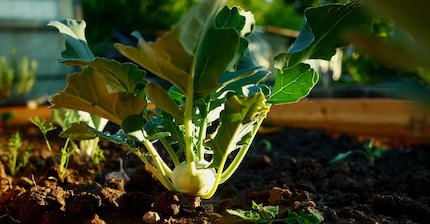
Start the gardening season with a cold frame
Anyone who can hardly wait to get their garden up and running can now get a cold frame. I'll tell you what a cold frame is, how it works, what you need to look out for and what you can grow in your cold frame.
Spring is just around the corner and you can hardly wait to get started in the garden? Then you're just like me. Depending on the weather, there may still be snow outside. The temperature can also easily drop below zero in March. But the tender little plants don't like this at all. So what to do? Use a cold frame and you can extend your gardening year by a good two months or more.
What is a cold frame?
The cold frame has long been used for growing early garden crops. It describes a flat cultivation area covered with glass. In the past, it was sunk into the ground, or rather there were pits around one metre deep. These were either lined with wood or bricked with concrete. This had the advantage that the plants were somewhat protected simply by being sunk into the ground. Old windows were placed on the foundation walls, which provided additional insulation and allowed enough light to pass through for the plants to grow. The windows could be raised, tilted or removed completely.
You can still find these partially walled cold frames in very old gardens and parks. A distinction is made between warm and cold cold frames. The warm cold frame was filled with so-called "manure packs" (various layers of straw, horse manure and compost). As the materials rotted, heat was released, which benefited the cultivated plants in the cold frame.

Directly sown kohlrabi develops excellently in the cold frame
Why a cold frame?
If you have a cold frame, you can sow or plant the first vegetables in your "mini-greenhouse" as early as February when the weather is good. The box shape and double-wall panels provide wonderful protection for the tender and frost-sensitive crops. But be careful: in very low temperatures, it is essential to provide additional protection against frost with bubble wrap (bubble wrap) or winter protection mats!
How does a cold frame work
A cold frame works like a small greenhouse. The sun's rays enter through the glass or the double-walled panels and heat up the air. The insulated walls provide protection from cold winds and icy weather, creating a microclimate that is very favourable for the plant.
Compared to a greenhouse, the growing area of the cold frame is smaller, but the purchase costs of the cold frame are all the cheaper. Smaller gardens benefit from the small space requirement and mobility of the cold frame.
How do I get my cold frame
Today, we are almost exclusively familiar with mobile cold frames, which are made from double-webbed panels and are available from garden centres or online. However, if you want to build a fixed cold frame in your garden, you can do so using wooden boards and old windows. Many good DIY instructions can be found on the internet.

Fixed cold frame made from wooden boards. Ventilation in warm temperatures is very important to prevent diseases.
What to look out for
A cold frame - just like a large greenhouse - must be regularly ventilated and, depending on the amount of sunlight, also shaded, i.e. protected from the sun's rays.
Maximum temperatures inside the cold frame should not exceed 22 - 25° degrees. If the cold frame is not ventilated automatically, you should ventilate it manually. A small piece of roof batten placed between the edge of the box and the window pane is usually sufficient. Don't forget to water regularly and "air out" in the evening.
Tip:
Excessively high temperatures and humidity favour diseases. That's why it's worth saving money when buying a cold frame and choosing a model with an electric window opener.
What do I plant in my cold frame
In principle, anything that can withstand lower temperatures when sowing or planting is suitable for the cold frame.
In practice, however, I recommend choosing early vegetable varieties for sowing. These are, for example, seeds of early carrots, early radishes, spring onions, any spring salads such as Asia salads or arugula. Herbs and flowers are also suitable. It is best to sow directly into the box and separate the plants that are sown too close together to the correct distance (see seed packet).
Here is a selection of the most common types of vegetables that you can sow directly into the cold frame:
- Cut and plucked lettuce
- Asian lettuce mixes
- Spring lettuces
- Lettuce (from the end of March)
- Spring onions
- Radishes
- Radish
- Spinach
- Kohlrabi
- Cauliflower
- White cabbage
- Chives
- Dill
- Parsley
Now I wish you every success with your first seeds and a good start to the gardening year!
I discovered my love for gardening very early on and later turned my passion into my profession. For a few years now, I’ve been regularly writing blog posts and publishing articles in the HomeGardening section of myPfadFinder.com. This is where I give readers tips and tricks on gardens and balconies and present my latest gardening videos.
Find out more about me here: <a href="http://www.andreas-homegardening.com/" target="_blank">www.andreas-homegardening.com</a>
Interesting facts about products, behind-the-scenes looks at manufacturers and deep-dives on interesting people.
Show all